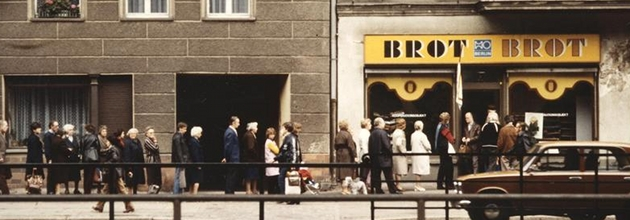In Part One of my overview of Mary Fulbrook’s The People’s State: East German Society from Hitler to Honecker (Amazon US, UK, CA, DE [english] and DE [deutsch]), I emphasized Professor Fulbrook’s assertion that most histories of East Germany concentrate on the “state versus society” angle, seeing the latter wholly as a repressed body governed and repressed by the former. As she makes clear in her introduction to the book, she believes the “state versus society” approach is unnecessarily and unnaturally limiting; a history that focuses only on the East German regime’s repression of dissent is, to some extent, ahistorical.
I also mentioned that in pursuing her newer, wider and, as she believes, more correct approach to East Germany’s history, Fulbrook appears to be at least somewhat worried that her own politics can be used against her, that she might be seen by some as downplaying the repressive elements of the dictatorship. As I noted, she therefore goes out of her way on several occasions to remind the readers that the regime was, in fact, a repressive dictatorship. (By the way, she makes this clear enough in another of her books concerning East Germany, Anatomy of a Dictatorship.)
Given her stance — and her own worries about how her stance might be received — I was really wondering just how far she would go in describing what we might call a “contented people” (not her phrase) in the later parts of the book where her arguments would be spelled out in greater detail. Let’s be specific here: I was asking myself, “Am I maybe going to come away thinking that East Germany wasn’t such a bad place?”
Having now read up to the book’s conclusion — and most importantly the section with the eyebrow-raising title, “The Participatory Dictatorship” — I can say that rather than getting the sense of any kind of contentment experienced by East German citizens, I instead come away with a much greater understanding of what could be considered “coping“: how most East Germans settled into the system, became a part of it and recognized their own limitations as to what they could change about it. So one of my overall reactions is that Professor Fulbrook probably did not need to worry too much that what she wrote would be considered a diminution of the repressive elements of East German society. I can say with certainty that in sections such as “The Participatory Dictatorship”, I did not feel in any way that Fulbrook plays down the repressive nature of the regime.
Rather, she simply provides a very interesting and thought-provoking description of how, in fact, the “State versus Society” model hardly existed. The State was the Society. How’s that?
The regime did a truly remarkable job integrating the society into the state by widening — to an extraordinary degree — the group of stakeholders who had something to benefit from the state. And I’m not just talking “benefits” in the form of health and education, but rather more in the form of making individuals feel that they are part of the state’s governance by providing them with responsibilities, no matter how pathetic (in retrospect) some of these responsibilities might seem. Much of this was simply manipulation, but a very clever manipulation indeed. That handful of people who truly held power at the top of the regime understood very clearly that they needed to give people a sense of (limited) power — or the appearance of power — to influence their local surroundings.
To that end, vast numbers of people were given some sort of “functionary” role. (The notion of “functionary” is very prominent in Chapter 11.) Fulbrook:
Implausibly large numbers — perhaps one in six of the population — were involved in one way or another in what might be called the micro-systems of power through which the GDR society worked. This system cannot be described in terms of an extended “state” that was “doing something” to a “society” conceived of as separate from the “state”: rather it was the very way society as a whole was structured. Life in the GDR, in just about every respect — including not only the obvious areas of the economy or the education system, but also housing and leisure — was organised in ways that were at the same time dependent on central policy decisions and on the practices of innumerable people who were active participants in the maintenance and functioning of the system on the ground.
Among them were 300,000-400,000 “key functionaries”, but then also another two million adults who
played a significant role as a functionary in one or more of the mass organizations, political parties and regional and local representative institutions such as the Stasi, the Army and the People’s Police, and the state administrative and economic apparatus.
…
[T]o try to call them all representatives of the “state”, rather than members of “society”, would be to make an artificial distinction that does not adequately depict the situation on the ground.[236-237]
She goes on to describe some of the “enormous number of functions” a citizen of the GDR could potentially hold. But it’s very important to note that she does not present this as some sort of ideal circumstance, as if it was “finally” a state in which “the people” could actively participant. I found her to be describing a rather more pathetic situation, though I’m not sure she would characterize it as such. For example, the “functionaries” would — unsurprisingly — use their functions as proof of commitment to the regime when asking (begging) for items of scarcity, such as apartments or management jobs. A certain type of class system emerged in this “classless” society.
She refers to the functionaries described above as a “benign” form of participation. That group was large enough as is, but we’ve not yet touched upon the “malign exercises of power” that could be undertaken by everyday members of society who, sadly, jumped at the opportunity. We’re speaking here of the informal collaborators (inoffizielle Mitarbeiter, or “IMs”) who worked with the Stasi, the notorious East German secret police. Fulbrook:
By way of comparison, the Gestapo employed 7,000 officials for a total population of 66,000,000 in Nazi Germany; the Stasi employed over 91,000 full-time staff in a GDR population of about 16,400,000 in 1989. [241]
And those were simply the official employees of the Stasi. By the 1980s there were 170,000-180,000 informal collaborators, “an average ratio of one informer to every 60 or so adults.” Given the turnover of IMs over the years, she estimates that a half million GDR citizens were informal collaborators of the Stasi during the Honecker years. So this was yet another and more sinister way in which society and state overlapped during the second German dictatorship.
Fulbrook’s The People’s State (UK, CA, DE [english] and DE [deutsch]) is full of interesting data such as the numbers I’ve just showed you. I believe she makes good use of the data and, overall, I found her argument very convincing. She need not have worried too much about her arguments being misinterpreted from a political perspective: I experienced the book as a series of very thorough empirical examinations followed up by completely plausible interpretations.
It’s dense stuff, meant (I imagine) not so much for a casual audience but rather for university study. Nevertheless, Fulbrook’s writing is very approachable — it’s only the detail that I think might put off the casual reader. Professor Fulbrook is very thorough! Personally, I like that.
Happy Reading!

Bill Dawson
P.S. For a dramatic interpretation of the methods of the Stasi — the East German secret police — check out the Oscar-winning film “The Lives of Others” (also available at Amazon UK, CA and DE). For a foreign-language film, “The Lives of Others” has an extraordinary 270+ reviews at Amazon.com, almost wholly positive. Here’s part of one:
‘The Lives of Others’ is 137 minutes of the best entertainment imaginable. Ulrich Mühe is an East German who himself was the target of Stasi oversight. For this film, he was awarded Best Actor at the 2006 European Film Awards. Is there a more just triumph than that?
Photo Credit
The lead photo accompanying this blog post is from the German Federal Archives which has kindly made it available via Wikimedia Commons under the Creative Commons Attribution Share Alike license. The photo shows participants of the Bundeskongress of the German League of Democratic Women (DFD), one of the many organizations that would have been in a position to provide “functionary” roles as described by Professor Fulbrook.





